Collaborative Initiative with IDEA StatiCa
The Faculty of Civil Engineering at Brno University of Technology (FCE BUT) has entered into a significant long-term collaboration with IDEA StatiCa, a renowned software solutions provider for structural design. The framework agreement, signed on November 28, 2024, emphasises the development of advanced numerical methods and their promotion within the international scientific community.
The main objectives of the collaboration:
- Scientific Research: Validation, verification, testing, physical experiments, and the application of artificial intelligence in structural design..
- Dissemination of Results: Publishing scientific articles, delivering lectures, participating in conferences, and presenting on social media platforms.
As part of the collaboration, FCE BUT established a specialised research team, the Laboratory for Numerical Structural Design (LNSD), which started to commence operations on January 1, 2025, at the Institute of Metal and Timber Structures. This team, consisting of researchers and doctoral students, will closely collaborate on advancing the science of structural design.
Long-Term Benefits for the Scientific Community and International Impact of the Partnership
IDEA StatiCa will provide expert know-how and financial support, ensuring the resources needed for complex research activities. Both parties share the goal of developing CBFEM and CSFM methods and disseminating them among structural design and assessment professionals.
“The collaboration between FAST VUT and IDEA StatiCa represents a unique connection between academic and industry. This synergistic initiative will enable significant advancements, contributing to the development of structural engineering on an international level,” stated Ing. Martin Vild, PhD., head of the LNSD team.
Numerical methods CBFEM (for steel and timber structures) and CSFM (for concrete structures) represent essential tools for precise modeling and design of structural elements. The CBFEM method was developed by IDEA StatiCa in collaboration with Brno University of Technology and the Czech Technical University in Prague, while the CSFM method originated from a partnership between IDEA StatiCa and ETH Zurich.
The signed agreement underscores the integration of scientific research with practical application. Together with IDEA StatiCa, FAST VUT aims to develop innovative technologies and strengthen its reputation within the global scientific community.
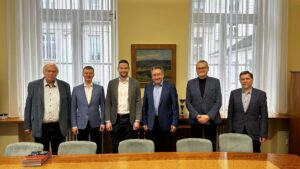

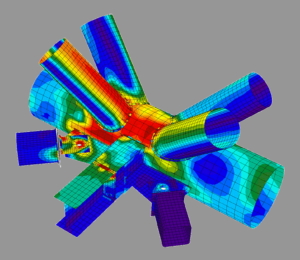
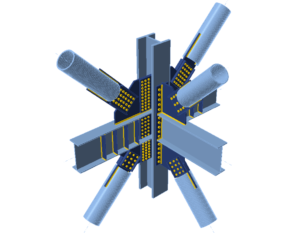
(Source: FCE BUT)
Actual Research Activities
Advanced Design of Steel Joints
Our research group at the Institute of Metal and Timber Structures has focused on the advanced design of steel-to-steel and steel-to-concrete joints for more than a decade. Finite element modelling became a standard design option, and the need for standardization was recognized by the development of prEN 1993-1-14:2024—Design assisted by finite element analysis. The main subject of the research is the behavior of components, such as bolts, welds, anchors, or column webs in transverse compression. One of the results is the Component Based Finite Element Method available in commercial software IDEA StatiCa and Hilti Profis developed with the contribution of several TAČR projects. The method is now officially recognized in AISC Design Guide 1: Base Connection Design for Steel Structures and is continuously being validated by experiments and numerical simulations.
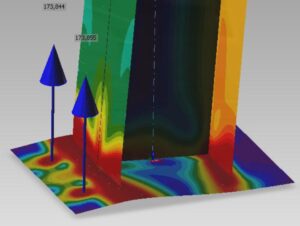
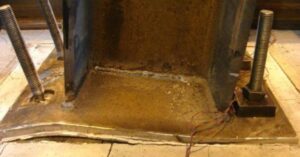
Steel Structures made of Thin-Walled Cold-Formed Profiles
One of the key research topics at our workplace in recent years is the structural design and experimental verification of the actual behaviour of steel structures made of thin-walled cold-formed members. Research focused on this field is conducted in cooperation with local and foreign companies. The research projects respond to requirements of the engineering practice for refinements of design procedures based on European design standards and aim to improve the structural design of thin-walled members and make it more efficient. It applies especially to secondary structures of hall objects, such as thin-walled purlins and girts, built-in ceiling constructions for storage purposes and constructions for components of photovoltaic devices. A closely related field is the stabilization of thin-walled members by cladding which can contribute to increase of resistance of the stabilized members and thus result in economic and reliable structural design. For application of load at the planar members, the vacuum test method is used which allows to realistically apply the distributed load. It was utilized e.g. for experimental investigation of stabilization of thin-walled cold-formed members by cladding. It is suitable for experimental verification of load-bearing resistance of planar members made of various materials and their combinations.

Timber Structures and Constructions of Wood-Based Materials
The use of wood in building constructions is relevant for reducing lifecycle costs of buildings and lowering the carbon footprint in the construction industry. Research and development activities are aimed at developing structural system components from solid wood for family houses (project TAČR FW01010579 “Innovative construction and production technologies of solid wood panels“, conducted from 2019-2023 in collaboration with Mendel University Brno) and developing large-format elements with enhanced properties based on CLT panels (project TAČR TN01000056/05 “Advanced wood-based and composite structural elements for civil construction“, conducted from 2019-2022). The practical outputs of the projects include functional samples and a verified technology. The newly developed structural elements meet the basic parameters of safe, economical, and especially ecological constructions for practical use.

GFRP Composites
GFRP (glass fiber reinforced polymer) which are used in transport infrastructure (bridges, railings, etc.), industry, energetics (stairs, platforms, etc.) or urban infrastructure (underground cable collectors, etc.). The advantage of GFRP composite materials is a favorable strength-to-weight ratio and, in particular, resistance to weathering and chemically aggressive environments. Thanks to this, GFRP structures are maintenance-free and do not require surface protection, which leads to lower life cycle costs and a reduced carbon footprint. The research is focused on the development of GFRP mixtures (various combinations of glass fibers and products, matrices and additives), on the analysis of member elements including stability problems (flexural buckling and lateral-torsional buckling) and on the structural design of complex joints and details. Structures and parts made of structural glass are an integral part of modern architecture. Whether they are used as a glass railings, stairs, canopy or facade, it is a load-bearing structure that must have sufficient load-bearing capacity, stability and resistance. The research is focused on the analysis of the behavior of glass members loaded by normal force (flexural buckling), bending moment (lateral-torsional buckling) and their interaction. Since there is not yet a valid design code for designing glass structures, the data obtained during load tests and numerical simulations can serve as a basis for the development of standard procedures. The goal is to design safe, reliable and aesthetic glass strucutres.

Structural Glass Structures
Structures and parts made of structural glass are an integral part of modern architecture. Whether they are used as a glass railings, stairs, canopy or facade, it is a load-bearing structure that must have sufficient load-bearing capacity, stability and resistance. Our research is focused on the analysis of the behaviour of glass members loaded by normal force (flexural buckling), bending moment (lateral-torsional buckling) and their interaction. Since there is not yet a valid design code for designing glass structures, the data obtained during load tests and numerical simulations can serve as a basis for the development of standard procedures. The goal is to design safe, reliable and aesthetic glass structures.